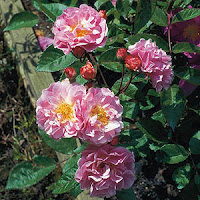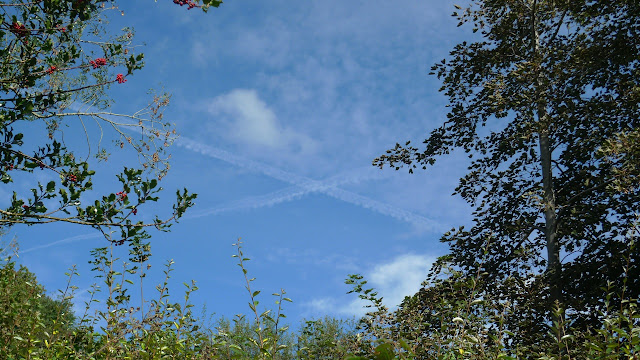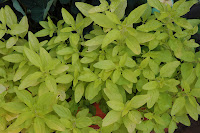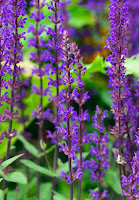 |
| Walking in Devon in November |
Just to update since my last post, I've recently joined a walking group which meets every Sunday morning, so I now get to enjoy some nature therapy beyond the garden as well. As I don't drive it is a bonus to reach those places that would take forever by bus, assuming public transport would even go there. As this year has been very wet there have been less gardening days than usual but at least I have now found someone reliable and reasonably priced to help me with jobs in the garden that I'm not coping with and he is coming on Monday morning (if it is not raining, although rain IS forecast) to help me burn the holly that is still stacked at the end of my garden.
I spent a whole afternoon the other week trying to get a bonfire going, but it kept going out. The holly I'd saved to make wreaths with (see earlier post) I had to finally chuck out as it was becoming brown and dry and all the berries were falling off despite being kept in buckets of water in my utility room. If I had known I was going to make holly wreaths I would have had the tree felled nearer Christmas, but it was just a way of recycling and I like to make things. I did save some of the berries and put them in the fat cakes I made for the birds, which are now stored in my freezer as there are still plenty of berries on the trees and bushes in this area for them not to need them just yet.
I have also bought a wooden bird table today to be delivered on Monday, which will be for the front garden so I can watch the birds and hopefully take some good photos of them. As the cats from the house next door never go in the front garden they should be safer there too. It was quite cheap compared with some I've seen on the internet, and I'm going to be painting it pale blue with acrylic paint when it arrives.
Plenty of jobs still to complete in the garden such as a broken fence, a summerhouse with no roofing felt, a collapsed deck and broken stone steps with crumbling dry stone walls. At least I had one major wall rebuilt this year, but the mature ivy vines have done a lot of damage to the short wall on the narrow terrace and I no longer have a stone waller after the last one disappeared without hearing a word from him again on that strange Friday, despite arranging to phone me to do my steps next. This wall will need mortar though so it is more a question of cementing in the stones that have fallen out, after which I plan to have clematis in pots to trail down the walls from up on the terrace.
RAMBLING and other ROSES
This month I'm ordering some rambling roses to disguise the mudslide of a collapsed wall which needs something to hold it together as the slope is very steep and I'm not sure what else I can do with it. My garden will never be a neat, manicured suburban garden as it is wild by nature. As are all the gardens on this particular higher level of town, which was once cleared woodland to grow fruit commercially for the London market. That's why it keeps wanting to revert back to woodland with blackberries, wild strawberries and ivy trying to take over as soon as my back is turned. The fact that neither of my immediate neighbours does any gardening at all doesn't help much, and the woman who lives two doors away told me that she can't even get outside her back door at all as it is so overgrown with brambles.
I'm ordering at least 3 rambling roses because if it is going to be a wild garden it might just as well be a wild, romantic garden. The ramblers will be strategically placed to stop all the neighbours' cats from taking a short cut across my garden. The cats have their own garden so no need to use mine as I want to attracts birds there. I even nailed a wooden nesting box for robins to the summerhouse which has never been used by any bird in the 2 years I've lived here. Instead a robin makes a nest in the tree next door where 3 cats live, and the cats eventually dragged the whole nest indoors.
But back to the rambling roses, I'm putting my short-list here as I've lost the rose notes I made a while back, either scribbled in a diary or on a computer document I can't find.
Rambling Rector (above) has large clusters of scented, semi-double, creamy-white flowers from July to September and is very vigorous. Ideal for covering an unsightly structure or scrambling through a robust tree, an excellent variety for wilder areas of the garden or for covering a north-facing wall. This one is for the end of the garden, what I refer to as the 'woodland garden' (as there are too many self-seeded trees there for the space) and I will try to train it to grow up a tree as it can reach about 30 feet in height.
The Cornelia rose is a hybrid musk and a great rose for a shaded place. It is very fragrant and has a unique color as well!
Many-flowered trusses of small, formal, rosette-shaped blooms of coppery-apricot which fades to a coppery-pink, it is a vigorous plant with good dark green foliage. Will form a good hedge 5 ft. x 5 ft. and they work equally well as a climber or a shrub.
They are nearly thornless so they are easy to handle and need very little pruning in most cases. Most importantly, they are relatively shade tolerant so they're a good choice for those tough spots without good sunlight. However, with sunlight it can be a very strong grower. This is on my shortlist for if I need a rose of this colour somewhere.
For a sunny spot on the terrace, to form a bit of a hedge between my garden and the lower end of the slope where the collapsed dry stone wall is (and at the moment only held together with weeds and dead ivy vines) I'll try this rose below.
Roseraie de l'Hay is a vigorous, dense shrub, with healthy apple-green foliage. Rich wine-purple, elongated buds, opening to four and a half inch, crimson-purple flowers in July to September. Strong perfume. One of the finest Rugosas. 7 ft. x 7 ft. It is a tough plant with good disease resistance with repeating blooms, and it tolerates a wide range of soils and even seaside conditions. It may keep next doors' brambles from encroaching into my garden or at least block them from view. The earth slope by the steps is far too steep to do anything with, and I need more varieties of plants to stop the soil erosion. Most of the slope can have white ground cover roses which will eventually join up with the magenta roses at the bottom of the slope. The following two white roses are possibilities, underplanted with creeping juniper. Once the slope is more stable I can risk weeding it.
Kent - A perpetual flowering ground cover rose. Pure white semi-double blooms. Tolerant of wet weather. Dense hugging growth. Size:30cm x 90cm. (12 x 35 inches)
Grouse - A densely growing very vigorous ground cover rose. Single pink to white bloom. Strongly scented. Excellent glossy healthy foliage. Summer flowering. Size:60cm x 3m.
(24 x nearly 10ft)
 |
| GROUSE GROUND COVER ROSE |
The creeping juniper would also be good for decorating wreaths, and I'd like to make one for each season, but I will need to find other plants and shrubs with different root depths to really stabilise that slope. Perhaps the man who is coming to help me sort out the garden can suggest some type of structure to go along with the plantings.
Once I have cleared the large pile of stones and rubble on the terrace, which I had been carrying in buckets to the end of the garden which is now inaccessible due to the holly branches awaiting the bonfire, I will have just enough space to put a small table and chair on the very narrow terrace, so I can have my morning tea up here while gazing at the distant hills where Dartmoor begins. The imagined potential for my garden has not so far lived up to the reality, and I have yet to relax in it and enjoy it as there is always much work to do. Hopefully next year will see better weather as I have only spent a few days gardening this year and none of the hard landscaping got done as originally planned, and neither did my pond project. Just as well that I also enjoy researching plants and re-designing my garden as I surf the internet.



































